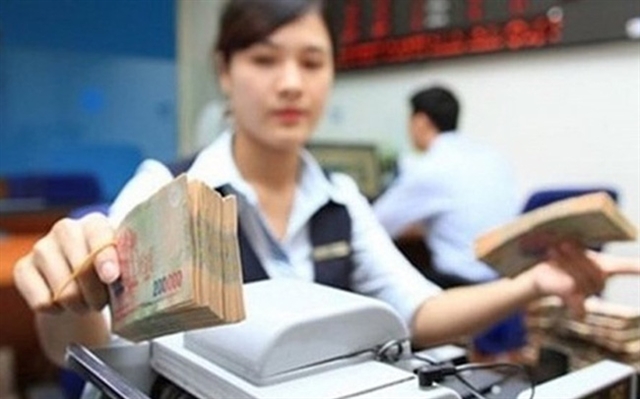 Economy
Economy

Việt Capital Commercial Joint Stock Bank (VietcapitalBank) offers the highest deposit interest rate of any bank: 8.6 per cent.

|
| Most commercial banks, including major ones, have recently increased their deposit interest rates to high levels especially for long terms. — Photo cafef.vn |
Compiled by Thiên Lý
Việt Capital Commercial Joint Stock Bank (VietcapitalBank) offers the highest deposit interest rate of any bank: 8.6 per cent.
The rate is applicable for deposits of 24-60 months.
For the same period, it offers 8.7 per cent if the deposits are made online.
NamABank and ABBank are also offering high rates of 8.3-8.45 per cent.
Most commercial banks, including major ones, have recently increased their deposit interest rates to high levels especially for long terms.
Eximbank is offering 8 per cent and MBBank is paying 7.7 per cent.
Besides being ready to pay these rates, many lenders have also been issuing certificates of deposit with very high interest rates.
VietABank, for instance, is offering 8.38 per cent for 24 months on amounts of at least VNĐ10 million (US$435).
Many banks are also vying with each other to pay even higher interest rates if deposits are made online.
Why?
Analysts have been pointing to some policy reasons for this.
They include the State Bank of Việt Nam (SBV)’s reduction of the ratio of short-term deposits that can be used for long-term loans from 45 per cent to 40 per cent this year.
But the latest reason is the pressure from the volatility in the exchange rate as a fallout of the trade war between the US and China.
The US recently raised tariffs on $200 billion worth of Chinese products to 25 per cent from 10 per cent and has started the process of slapping tariffs on another $300 billion worth of goods.
In retaliation, China has announced higher tariffs on thousands of US goods.
This has had a significant impact on exchange rates, with the dollar appreciating against currencies globally including the đồng.
The exchange rate between the đồng and the greenback has been very volatile in the past few weeks, with the Vietnamese currency weakening.
The central bank has had to constantly adjust the daily reference exchange rate, taking it beyond VNĐ23,000 to the dollar on April 23 and gradually to new lows since then.
Analysts at Bảo Việt Securities Company (BVSC) said this has put pressure on interest rates since banks have to compete for the public’s money with the greenback.
Higher deposit interest rates obviously mean lending interest rates will increase commensurately.
At a meeting with enterprises in April in HCM City, SBV Deputy Governor Đào Minh Tú said the central bank has instructed commercial banks to try and keep lending interest rates steady this year.
But analysts said this looks to be a rather difficult task due to a number of internal and external factors like the China-US trade war and inflationary pressure due to hikes in electricity and fuel prices.
Not only deposit interest rates but lending rates too have shown signs of rising since the beginning of the year.
Many banks have increased interest rates on loans for buying or repairing houses and purchasing autos to 13-13.5 per cent and on consumer loans to 40-50 per cent.
The central bank has fixed the credit growth target for the banking industry this year at a rather low level of 14 per cent, which is also a reason for banks hiking loan interest rates.
Ships set to use cleaner fuel, freight rates to spike
The International Maritime Organisation (IMO) has announced it will enforce a new 0.5 per cent global sulphur cap on fuel content from January 1 next year, down from the current 3.5 per cent.
The tightening is part of the IMO's response to rising environmental concerns, contributed in part by harmful emissions from ships.
It has made shipping companies worried because they will be forced to use cleaner fuel once the new regulation comes into effect.
This will slash emissions of sulphur, which is blamed for causing respiratory diseases and is a component of acid rain that damages vegetation and wildlife.
But the energy and shipping industries are ill-prepared, analysts said, with refiners likely to struggle to meet higher demand for cleaner fuel and few ships fitted with equipment to reduce sulphur emissions.
Besides paying higher prices for the cleaner fuel, the shipping industry will also have to invest large sums of money on installing new equipment in vessels.
IMO estimates some 70,000 vessels will be hit by this new rule, and the additional cost per year for ship owners will be around $50 billion.
Đào Trọng Khoa, chairman of T&M Forwarding Company, told Thời báo Kinh tế Sài Gòn (Saigon Economic Times) that most shipping companies in Việt Nam now collect a low sulphur surcharge (LSS) on some routes but would have to apply LSS on all their remaining routes once the new rule takes effect next year.
The estimated surcharge is $100 per TEU.
In Việt Nam, the shipping industry’s additional cost per year on cleaner fuel is estimated at $10-15 billion, Khoa said.
This comes on top of several hikes in the prices of fuel this year and a recent hike in power tariffs.
It might be the final blow for the domestic container shipping industry, which suffers from oversupply.
The new surcharge due to the IMO’s new regulation is expected to make up between 10 and 15 per cent of freight charges, which could severely affect shippers.
Many export and import companies are worried about sharp increases in freight charges, especially at the end of this year when foreign trade often increases sharply.
The higher freight charges would not only affect their turnover and profit but also the competitiveness of Vietnamese goods.
Analysts have called on Vietnamese shipping firms to prepare well to minimise the impacts. — VNS









